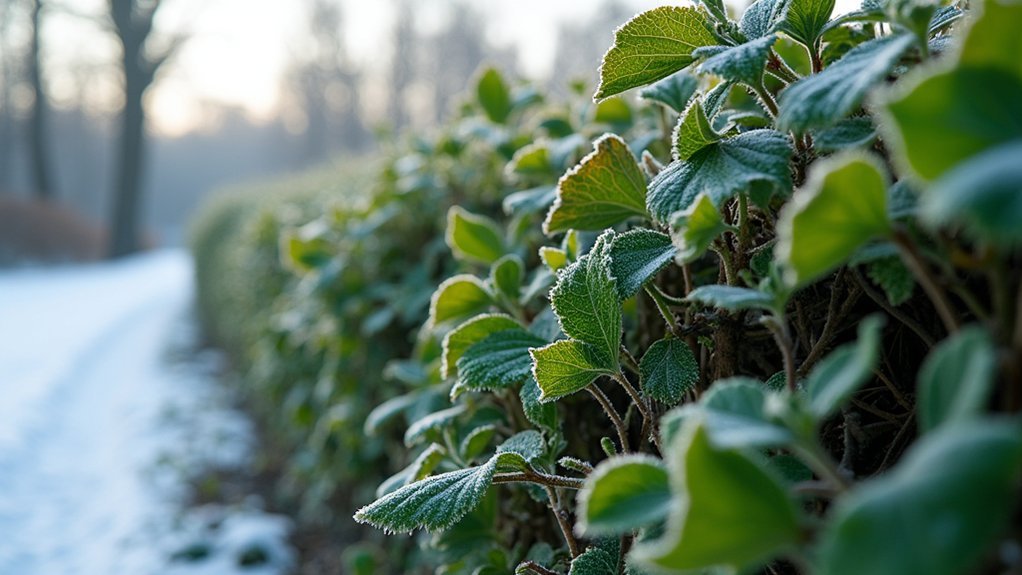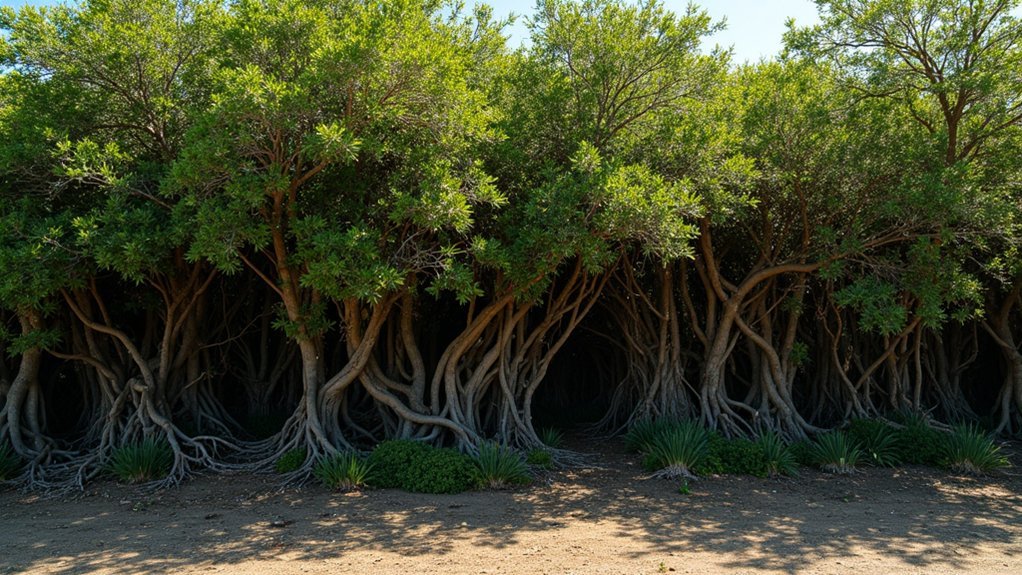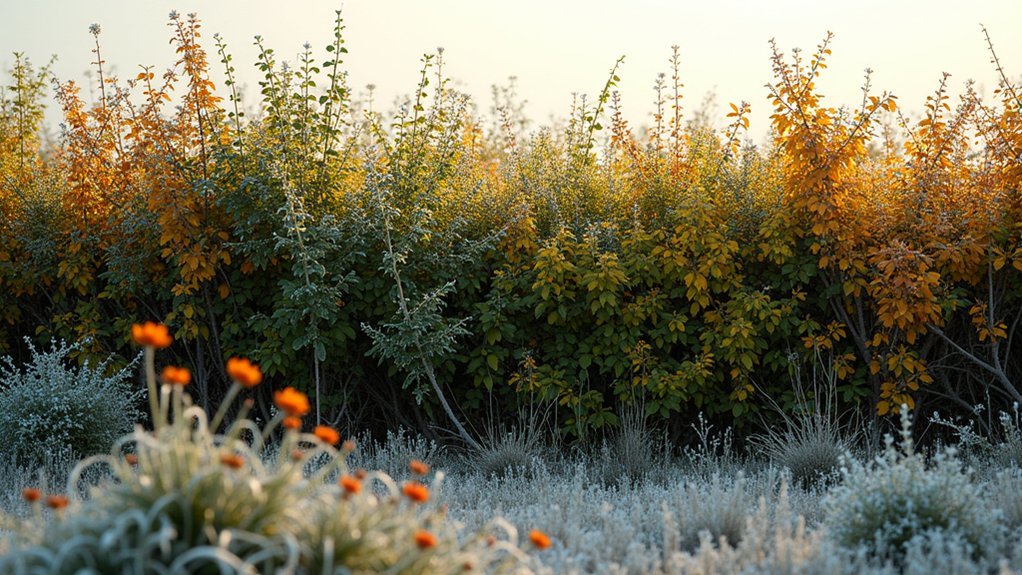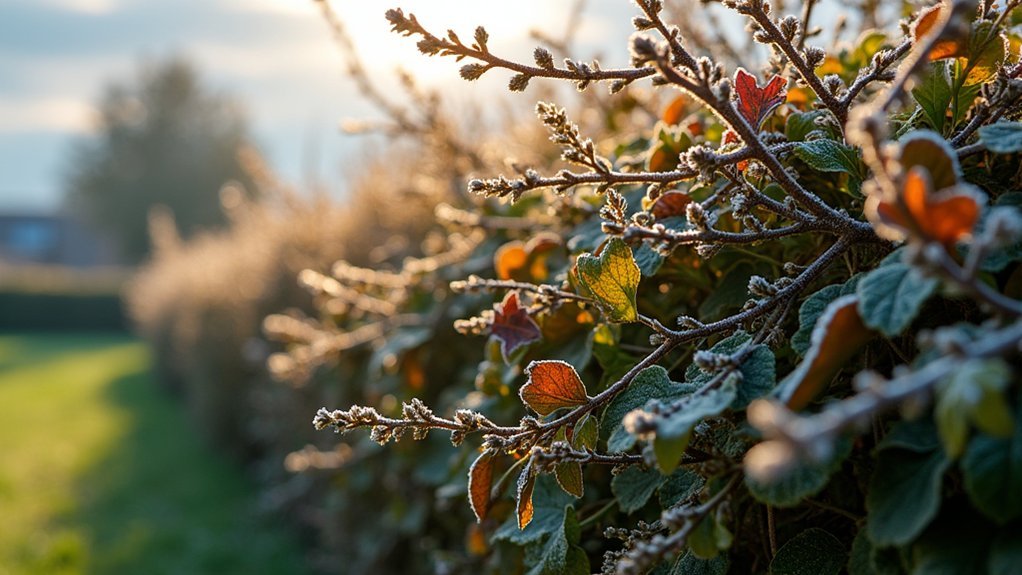Hedgerows survive extreme temperatures through their dense structure and diverse plant composition. You’ll find they create microclimates that buffer against extremes, with canopies absorbing 75-90% of solar radiation and roots accessing deeper, stable soil environments. Their varied species provide complementary survival strategies—some thrive in heat while others endure frost. Strategic orientation further enhances resilience, with south-facing hedgerows capturing sunlight and north-facing ones providing cooling shade. Discover how these living boundaries adapt to our changing climate.
What Makes Hedgerows Survive Extreme Temperature Shifts?

While hedgerows provide important ecological functions in agricultural landscapes, they’re surprisingly vulnerable to temperature extremes compared to woodlands. You’ll notice hedgerows experience higher maximum and lower minimum temperatures, making them less buffered against rapid temperature changes.
Effective hedgerow management is vital for enhancing thermal resilience. Strategic structural modifications can reduce edge effects and improve wind protection, minimizing extreme temperature impacts.
The spatial configuration of hedgerows directly affects air mixing and local wind speeds, which influences their ability to withstand temperature fluctuations.
Site-specific characteristics and ambient macroclimate conditions determine a hedgerow’s thermal buffering capacity. Without proper management, these habitats face increased frost risks in spring and autumn, accelerating biodiversity loss.
Understanding microclimate dynamics within hedgerows is essential for maintaining their ecological value amid increasingly volatile climate conditions.
The Microclimate Advantage of Dense Hedgerow Structures
Dense hedgerow structures create remarkably different microclimates compared to their surrounding landscapes, offering protection against extreme temperature variations.
You’ll find these living barriers reduce wind speed considerably, creating sheltered pockets where temperature fluctuations are less severe.
Unlike woodlands, hedgerows display distinct thermal characteristics—warmer maximum temperatures (by 0.506°C) and cooler minimums (by 0.239°C).
This unique microclimate advantage provides vital thermal buffering that shields sensitive plant and animal species from temperature extremes.
During summer, the slightly higher mean temperatures (0.202°C) within hedgerows influence growth patterns and reproductive timing of understory vegetation.
This microclimatic modification supports greater biodiversity by creating favorable conditions for species that might otherwise struggle in open environments.
For conservation efforts, understanding these temperature-regulating properties is essential when developing strategies to protect biodiversity amid increasing climate variability.
Root System Resilience During Temperature Extremes

As climate extremes intensify, the impressive root networks of hedgerow plants serve as their hidden survival mechanism.
These extensive root systems allow hedgerows to withstand temperature extremes by accessing deeper, more stable soil environments where conditions remain moderate despite surface fluctuations.
You’ll find hedgerow plants particularly resilient because:
- Their deep roots stabilize soil structure, improving water retention during drought conditions
- They exhibit remarkable phenotypic plasticity, adapting root growth to changing soil temperatures
- Well-established roots can reach cooler soil layers, providing refuge during heat waves
- Their ability to regenerate after root pruning guarantees continued adaptation to fluctuating climate conditions
This underground architecture explains why hedgerows continue to thrive when other vegetation struggles, making them valuable assets in our increasingly unpredictable climate.
Species Diversity as a Buffer Against Climate Stress
You’ll find that diverse hedgerows create a powerful buffer against climate extremes through complementary survival strategies among different species.
When temperatures fluctuate drastically, various plants and animals employ different adaptations—some conserve water, others adjust their activity patterns, creating a collective resilience that single-species environments lack.
These complementary approaches work alongside microhabitat temperature regulation, where the physical structure of hedgerows creates protective pockets with moderated temperatures, allowing vulnerable organisms to shelter during heat waves or cold snaps.
Complementary Survival Strategies
When extreme temperatures threaten ecosystem stability, hedgerows offer a remarkable insurance policy through their diverse species composition. This biodiversity under climate change isn’t just about quantity—it’s about complementary adaptations working together.
You’ll find that hedgerow species have evolved different approaches to survive temperature extremes:
- Varied root structures penetrate soil at different depths, maximizing water access during drought conditions.
- Different flowering times guarantee continuous resources for pollinators regardless of seasonal temperature anomalies.
- Diverse growth forms create microhabitats that buffer against temperature extremes.
- Complementary ecological functions maintain ecosystem services when individual species struggle.
This species composition creates resilience through redundancy—when certain plants falter under stress, others step in to maintain ecological functions, allowing hedgerows to withstand temperature fluctuations that would devastate monocultures.
Microhabitat Temperature Regulation
Unlike open fields that experience dramatic temperature swings, hedgerows create sophisticated temperature buffers through their diverse plant architecture.
When you examine a hedgerow closely, you’ll notice how its layered structure moderates the microclimate, keeping minimum temperatures warmer and maximum temperatures cooler than surrounding areas.
This temperature regulation happens because different plant species create distinct microhabitat zones within the hedgerow. The sub-canopy conditions effectively shield sensitive organisms from late spring and early autumn frosts—critical protection for vulnerable species like Anemone nemorosa and Geum urbanum.
You’ll find that these temperature-stabilizing properties aren’t just beneficial for plants; they support entire ecological networks.
The consistent microhabitat conditions foster biodiversity and strengthen ecosystem functions like pollination and pest control, enhancing the hedgerow’s resilience against climate change pressures.
Canopy Protection Mechanisms in Mature Hedgerows

When you examine mature hedgerows, you’ll find multi-layered leaf structures that absorb up to 90% of solar radiation, creating essential shade during temperature extremes.
These hedgerows feature wind-breaking dense growth that modifies local airflow, limiting warm air transport and establishing protective microclimates for understory species.
Their sophisticated moisture retention systems support evapotranspiration processes that actively cool surrounding areas during heat events while trapping humidity that moderates nighttime temperature drops.
Multi-Layered Leaf Structure
Though easily overlooked, the multi-layered leaf structure of mature hedgerows serves as a sophisticated defense system against temperature extremes. This natural architecture absorbs 75-90% of solar radiation, creating a stable microclimate that protects everything beneath it.
You’ll find this layering provides four remarkable benefits:
- Thermal regulation – Captures sunlight before it reaches the ground, preventing overheating
- Wind barrier protection – Reduces air movement that would otherwise transport heat away
- Natural air conditioning – Evapotranspiration from leaves actively cools surrounding air
- Nighttime insulation – Traps outgoing heat radiation, preventing frost damage during cold nights
This intricate structure doesn’t just survive temperature shifts—it actively mitigates them, creating distinct microenvironments that support diverse species through even the most challenging climate conditions.
Wind-Breaking Dense Growth
As extreme weather events intensify globally, the dense, interlocking structure of mature hedgerows provides critical wind-breaking protection that stabilizes local microclimates.
You’ll notice that mature hedgerows create a protective canopy that greatly reduces wind speed, buffering against temperature extremes that would otherwise stress local ecosystems. This wind-breaking function is essential—when harsh winds are blocked, temperature fluctuations diminish and moisture retention improves beneath the hedgerow’s shelter.
The canopy structure works as both shield and insulator, absorbing solar radiation during heat waves while providing insulation during cold snaps.
This microclimate regulation is especially beneficial for understorey species that might otherwise struggle during extreme conditions. The complex vegetation layers create diverse habitats that enhance ecosystem resilience, allowing multiple species to find suitable niches regardless of external temperature shifts.
Moisture Retention Systems
The intricate canopy structure of mature hedgerows functions as a sophisticated moisture retention system during extreme temperature events.
You’ll find these living barriers working tirelessly to protect your landscape by slowing wind speed, which considerably reduces evaporation from both soil and plant surfaces.
When extreme weather strikes, hedgerows provide:
- Critical shade that keeps soil temperatures lower, preventing excessive moisture loss during heat waves
- A natural storage system where dense foliage captures and gradually releases rainwater
- Rich soil organic matter from decaying plant material that works like a sponge, holding water for extended periods
- Microclimate zones with varying humidity levels that shelter vulnerable vegetation
This remarkable moisture retention capability means hedgerows not only survive temperature extremes but also protect surrounding ecosystems during increasingly unpredictable weather patterns.
Soil Insulation Properties Within Hedgerow Ecosystems

While open agricultural fields experience dramatic temperature swings, soil within hedgerow ecosystems enjoys remarkable thermal stability thanks to natural insulation properties.
You’ll find temperature variations reduced by 1-2°C compared to surrounding areas, creating ideal conditions for root development and microbial communities.
This soil insulation stems from multiple sources. The dense vegetation canopy acts as a protective shield, moderating temperature fluctuations and reducing direct sunlight exposure.
Hedgerow canopies provide natural soil insulation, protecting against temperature swings while reducing exposure to harsh sunlight.
Decomposing organic matter enriches soil structure while contributing to thermal regulation, effectively buffering against temperature extremes.
Diverse root networks further enhance this effect by improving soil aeration and moisture retention.
Together, these elements create a resilient underground environment that maintains consistent conditions even during challenging weather events, supporting the hedgerow’s ability to withstand environmental stresses.
Water Retention Capabilities During Temperature Fluctuations
During extreme temperature events, hedgerows demonstrate remarkable water management capabilities that extend well beyond their visible boundaries.
You’ll find these natural barriers actively combating the effects of extreme temperature shifts through their advanced water retention systems.
When temperatures fluctuate drastically, hedgerows provide:
- A natural shield against soil erosion on hillsides, preserving precious moisture that would otherwise be lost
- Dense vegetation that reduces wind speed by up to 50%, considerably decreasing evaporation rates
- Rich organic matter from decaying plants that transforms soil into a natural sponge
- Deep root networks that access underground water sources, maintaining resilience when surface moisture depletes
These capabilities make hedgerows invaluable assets in landscapes vulnerable to both drought and flooding during unpredictable climate events.
Adaptive Growth Patterns in Response to Seasonal Shifts

Your hedgerow plants develop remarkable root system resilience when confronted with extreme temperature shifts, extending deeper during droughts and forming protective networks during frost.
You’ll notice how their canopy structure adapts seasonally, creating self-regulating microclimates that can be up to 5°C cooler in summer and 3°C warmer in winter than surrounding areas.
This temperature regulation capability allows species like Anemone nemorosa to modify their growth patterns strategically, conserving resources during stress periods while maximizing growth during ideal conditions.
Root System Resilience
As temperatures fluctuate to unprecedented extremes, hedgerow plants demonstrate remarkable root system resilience through adaptive growth strategies.
You’ll find these plants developing extensive networks beneath the soil that enable them to thrive despite climate challenges.
Hedgerow root systems combat extreme temperatures through:
- Deep penetration – Roots extend downward to access water tables that remain stable even during droughts
- Phenotypic plasticity – Roots physically reshape themselves in response to warming conditions
- Resource optimization – Species like hawthorn adjust their growth patterns to reduce competition during heat stress
- Carbon sequestration – Their extensive root networks capture carbon while stabilizing soil structure
This resilience isn’t just about survival—it’s how hedgerows continue contributing to ecosystem health while facing increasingly unpredictable climate patterns.
Canopy Temperature Regulation
While extreme temperature shifts challenge most ecosystems, hedgerow canopies develop sophisticated regulation mechanisms that create protective microclimates.
You’ll notice these dense canopies absorb substantial solar radiation, effectively regulating temperatures within the hedgerow structure.
This canopy temperature regulation isn’t just beneficial—it’s critical. Hedgerows experience lower maximum temperatures during heat waves and slightly higher minimums during cold snaps compared to surrounding areas affected by habitat fragmentation.
The diverse plant species contribute to this resilience, displaying varying adaptive growth patterns as seasons change.
Wind modification and evapotranspiration further stabilize temperatures in hedgerows.
The cooling effect from plant moisture release helps surrounding species survive extreme heat, while the reduced air mixing creates a buffer against temperature fluctuations.
This microclimate stability explains why hedgerows remain resilient when other ecosystems struggle.
Windbreak Functions and Their Thermal Regulation Effects
When planted strategically across landscapes, hedgerows serve as powerful natural windbreaks that dramatically alter local climate conditions. As wind hits these dense vegetative barriers, speeds can drop by up to 60%, immediately changing your farm’s microclimate.
This windbreak function creates thermal refuge zones where plants and wildlife can thrive despite external temperature extremes.
You’ll notice four significant benefits:
- Temperature moderation – up to 0.8°C cooler in summer when compared to open fields
- Enhanced moisture retention – preserving vital soil hydration during droughts
- Heat stress reduction – protecting sensitive crops from scorching conditions
- Warming shelter – retaining heat during cold snaps, preventing frost damage
These microclimatic conditions don’t just happen—they’re the direct result of hedgerows’ physical structure disrupting airflow and redistributing solar radiation across your landscape.
Hedgerow Orientation and Its Impact on Temperature Management
The direction you plant your hedgerows fundamentally shapes their effectiveness as temperature regulators. South-facing hedgerows capture maximum sunlight, creating warmer microclimates, while north-facing ones provide extended shade periods—each offering distinct advantages depending on your climate challenges.
For ideal temperature management, consider strategic positioning along slopes to improve drainage and reduce frost pockets.
You’ll want to vary the height and density of your hedgerow structure to control wind flow and moderate temperature extremes. Dense plantings create superior shelter from cold winds, stabilizing temperatures year-round.
To enhance microclimate benefits, incorporate diverse plant species with varied canopy layers. This diversity boosts resilience during heat waves by providing additional shade.
Remember that regular maintenance and selecting species appropriate for specific orientations will considerably improve your hedgerow’s ability to withstand temperature extremes.
Edge Effects and Their Role in Climate Resilience
Hedgerow edges create powerful ecological boundaries that fundamentally shape climate resilience in agricultural landscapes. When you observe these margins closely, you’ll notice how edge effects generate unique microclimates that buffer against temperature extremes that would otherwise stress vulnerable species.
These edge effects contribute to climate resilience through:
- Creating thermal refuges with higher maximum and lower minimum temperatures than surrounding woodlands
- Modifying local wind patterns to reduce the impact of harsh weather events
- Providing critical shelter during extreme temperature shifts, giving wildlife time to adapt
- Establishing microclimate gradients that support diverse species assemblages even during climate stress
Understanding these dynamics isn’t just academically interesting—it’s essential for managing hedgerows that can withstand increasingly unpredictable temperature extremes in our changing climate.
Comparative Temperature Buffering: Hedgerows vs. Woodlands
Despite their superficial similarities, hedgerows and woodlands differ considerably in their temperature buffering capabilities. While you might assume these linear vegetation features provide similar climate protection, research shows hedgerows experience higher temperatures year-round, with mean temperatures 0.102°C above woodlands and summer maximums 0.800°C warmer.
You’ll notice hedgerows offer reduced thermal buffering during extreme temperature events, making them less protective than woodlands during climate shifts.
| Feature | Hedgerows | Woodlands |
|---|---|---|
| Mean Temperature | +0.102°C higher | Better buffering |
| Summer Maximum | +0.800°C higher | Cooler extremes |
| Minimum Temperature | -0.239°C lower | Warmer minimums |
This temperature differential matters for plant survival, particularly during heat waves where woodland buffering provides essential protection that hedgerows can’t match.
Plant Adaptations Specific to Hedgerow Environments
While temperature buffering varies between vegetation structures, plants residing in hedgerows have evolved remarkable adaptations to thrive in these unique microclimates.
Hedgerow species like Anemone nemorosa display phenotypic plasticity, allowing them to adjust their growth patterns in response to temperature extremes.
You’ll find these plant adaptations particularly fascinating:
- Specialized leaf structures with waxy coatings that reduce water loss during heat waves
- Extended root systems that access deeper moisture sources during drought conditions
- Microclimate utilization that protects sensitive growth stages from sudden frost or heat
- Genetic diversity across hedgerow communities that guarantees some plants will survive even when others struggle
These adaptations make hedgerow species exceptionally resilient to climate stressors, showcasing nature’s ingenious evolutionary responses to environmental challenges.
Frequently Asked Questions
How Long Do Hedgerows Last?
Your hedgerows can last for several decades or even centuries. With proper maintenance, they’ll typically survive 100+ years. Regular trimming and care extend their lifespan, ensuring they remain healthy and resilient for generations.
What Are the Disadvantages of Hedgerows?
You’ll find hedgerows have several downsides: they compete for light, harbor invasive species, suffer structural damage in extreme weather, collect agricultural runoff, and when fragmented, limit wildlife movement and genetic diversity.
What’s the Difference Between a Hedge and a Hedgerow?
You’ll find that a hedge is a single row of shrubs or trees maintained for privacy or boundaries, while a hedgerow is a wider, more diverse ecosystem that functions as wildlife habitat and ecological corridor.
Why Does England Have so Many Hedgerows?
You’ll find England’s abundant hedgerows stem from centuries of agricultural tradition. They’ve served as field boundaries and livestock barriers since Anglo-Saxon times, while also providing essential wildlife habitats and supporting ecological diversity that persists today.
In Summary
You’ve seen how hedgerows survive extreme temperatures through microclimates, deep root systems, and diverse plant species. They’re natural temperature buffers, with their dense structure and strategic orientation protecting against harsh conditions. Next time you’re walking past these living boundaries, notice how they’ve adapted specifically to edge environments. By understanding these resilience mechanisms, you’ll appreciate why hedgerows continue to thrive despite our changing climate.





Leave a Reply